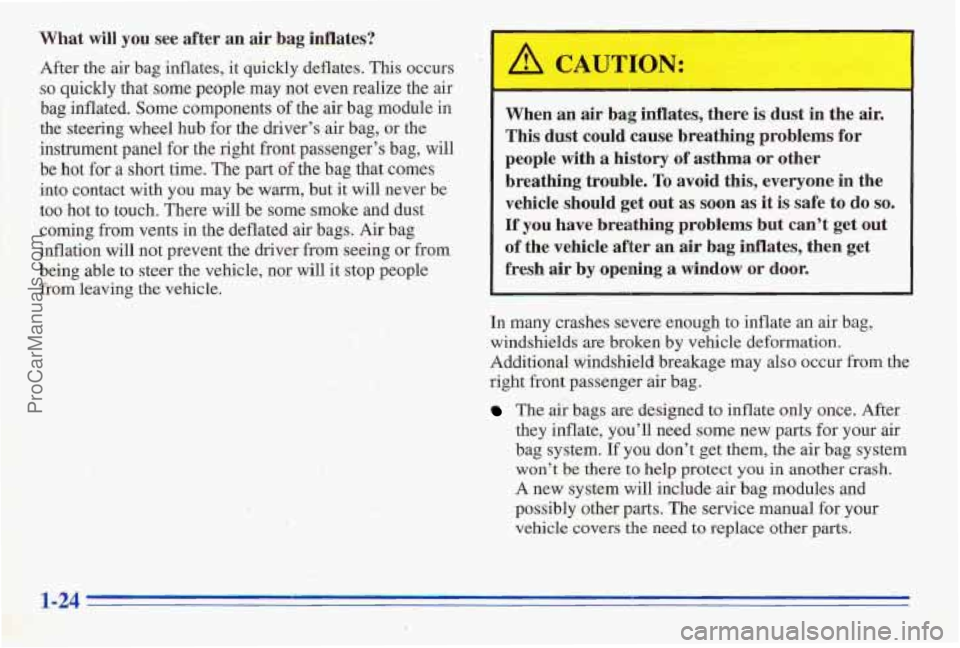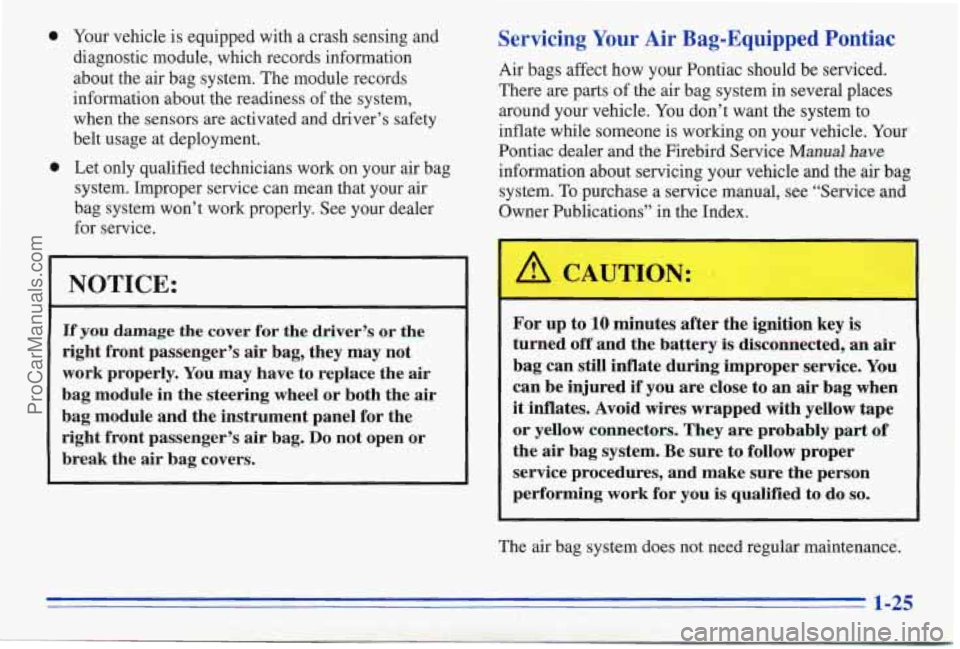PONTIAC FIREBIRD 1996 Owner's Guide
Manufacturer: PONTIAC, Model Year: 1996, Model line: FIREBIRD, Model: PONTIAC FIREBIRD 1996Pages: 386, PDF Size: 19.18 MB
Page 31 of 386

What will you see after an air bag inflates?
After the air bag inflates, it quickly deflates. This occurs
so quickly that some people may not even realize the air
bag inflated. Some components
of the air bag module in
the steering wheel hub for the driver’s air bag, or the
instrument panel for the right front passenger’s bag, will
be hot for a short time. The part
of the bag that comes
into contact with you may
be warm, but it will never be
too hot to touch. There will be some smoke and dust
coming from vents in the deflated air bags. Air bag
inflation will not prevent the driver from seeing or from
being able to steer the vehicle, nor will it stop people
from leaving
the vehicle.
I A CAUTION:
When an air bag inflates, there is dust in the air.
This dust could cause breathing problems for
people with a history
of asthma or other
breathing trouble.
To avoid this, everyone in the
vehicle should get out as soon
as it is safe to do so.
If you have breathing problems but can’t get out
of the vehicle after an air bag inflates, then get
fresh air by opening
a window or door.
In many crashes severe enough to inflate an air bag,
windshields are broken by vehicle deformation.
Additional windshield breakage may also occur from the
right front passenger air bag.
The air bags are designed to inflate only once. After
they inflate, you’ll need some new parts for your air
bag system. If
you don’t get them, the air bag system
won’t be there to help protect you in another crash.
A new system will include air
bag modules and
possibly other parts. The service manual for your
vehicle covers
the need to replace other parts.
1-24
ProCarManuals.com
Page 32 of 386

0
0
Your vehicle is equipped with a crash sensing and
diagnostic module, which records information
about the air bag system.
The module records
information about the readiness of the system,
when the sensors are activated and driver’s safety
belt usage at deployment.
Let only qualified technicians work
on your air bag
system. Improper service can mean that your air
bag system won’t work properly. See your dealer
for service.
~~
NOTICE:
If you damage the cover for the driver’s or the
right front passenger’s air bag, they may not
work properly. You may have to replace the air
bag module in the steering wheel or both the
air
bag module and the instrument panel for the
right front passenger’s air bag.
Do not open or
break the air bag covers.
Servicing ,Your Air Bag-Equipped Pontiac
Air bags affect how your Pontiac should be serviced.
There are
parts of the air bag system in several places
around your vehicle. You don’t want the system to
inflate while someone is working on your vehicle. Your
Pontiac dealer and the Firebird Service
Manual have
information about servicing your vehicle and the air bag
system.
To purchase a service manual, see “Seririce and
Owner Publications” in the Index.
I A CAUTION:
II
For up to 10 minutes after the ignition key is
turned off and the battery is disconnected, an air
bag can still inflate during improper service. You
can be injured if you are close to an air bag when
it inflates. Avoid wires wrapped with yellow tape
or yellow connectors. They are probably part of
the
air bag system. Be sure to follow proper
service procedures, and make sure’ the person
performing work for you is qualified to do
so.
’he air bag system does not need regular maintenance.
ProCarManuals.com
Page 33 of 386

Safety Belt Use During Pregnancy
Safety belts work for everyone, including pregnant
women. Like all occupants, they are more likely to be
seriously injured if they don’t wear safety belts. The
best way
to protect the fetus is to protect the
mother. When
a safety belt is worn properly, it’s more
likely that the fetus won’t be hurt in
a crash. For
, pregnant women, as for anyone, the key to making
safety belts effective
is wearing them properly.
A pregnant woman should wear a lap-shoulder belt, and
the lap portion should be worn as low as possible, below
the rounding, throughout the pregnancy.
Right Front Passenger Position
The right front passenger’s safety belt works the same
way as
the driver’s safety belt. See “Driver Position,’’
earlier in
this section.
I
1-26
ProCarManuals.com
Page 34 of 386

Rear Seat Passengers
It’s very imprtant for rear seat passengers to buckle up!
Accident statistics show that unbelted people in the rear
seat are
hurt mre often in crashes than those who are
wearing safety belts.
Rear passengers who aren’t safety belted can be thrown
out
of the vehicle in a crash. And they can strike others
in the vehicle who are wearing safety belts.
1.
Lap-Shoulder Belt
The rear seats have lap-shoulder belts. Here’s how to
wear one properly.
l.
Pick up the latch plate and pull the belt across you.
Don’t let it get twisted.
On convertible models, the shoulder belt may lock if
you pull the belt across you very quickly. If this
happens, let the belt go back slightly to unlock
it.
Then.pul1 the belt across you more slowly.
Push’the
latch plate into the buckle until it clicks.
i’
1-27
ProCarManuals.com
Page 35 of 386

If the belt stops before it reaches the buckle, tilt the latch
plate and keep pulling until
you can buckle it.
Pull .up on the latch plate
to make sure it is secure.
If the belt is not long enough, see “Safety Belt
Extender” at the end of this section. Make sure the
release button on the buckle is positioned
so you would
be able to unbuckle the safety belt quickly if
you ever
had to.
3. To make the lap part tight, pull down on the buckle
end of the belt as you pull up on the shoulder part.
1-28
ProCarManuals.com
Page 36 of 386

The lap part of the belt should be worn low and snug on
the hips, just touching the thighs. In a crash, this applies force to the strong pelvic bones. And you’d be less likely \
to slide under the lap belt. If you slid under
it, the belt
would apply force at your abdomen.
This could cause
serious or even fatal injuries. The shoulder belt should
go
over the shoulder and across the chest. These parts of the
body are best able to take belt restraining forces.
The safety belt locks
if there’s a sudden stop or a crash.
On convertible models, the safety belt also locks
if you
pull the belt very quickly out of the retractor.
~
You can be seriously hurt if your shoulder belt is
too loose. In a crash, you would move forward
too much, which could increase injury. The
shoulder belt should
fit against your body.
1-29
ProCarManuals.com
Page 37 of 386

Children
To unlatch the belt, just push the button on the buckle. Everyone
in a vehicle needs protection! That includes
infants and all children
smaller than adult size. In fact,
the law in every state in the United States and in every
be
Canadian province
says children up to some age must
restrained while in a vehicle.
Smaller Children and Babies
Sder children and babies should always be
restrained in a child or infant restraint. The
instructions
for the restraint will say whether it is
the right type and size for your child. A very
young child’s hip bones are
so small that a
regular belt might not stay low on the hips, as it
should. Instead, thle belt wiIl likely be over the
child’s abdomen.
In a crash, the belt would apply
force
right on the child’s abdomen, which could
criuse
serious or fatal injlaries. So, be sure that
any child
small enough for one is always properly
restrained
m a child or infhnt restraint.
ProCarManuals.com
Page 38 of 386

-
Never hold a baby in your arms while riding in a
vehicle. A baby doesn’t weigh much --. until a
crash. During a crash a baby will become
so
heavy you can’t hold it. For example, in a crash
CAUTION: (Continued)
CAUTION: (Continued) I
at only 25 mph (40 km/h), a 124b. (5.5 kg) baby
will suddenly become a 240-lb. (110 kg) force on
your arms. The baby would be almost impossible
to hold.
Secure the baby in an infant restraint.
1-31
ProCarManuals.com
Page 39 of 386

Child Restraints
Be sure the child restraint is designed to be used in a
vehicle. If it is, it will have a label saying that it meets
Federal Motor Vehicle Safety Standards.
Then follow the instructions for the restraint.
You may
find these instructions on the restraint itself or in a
booklet, or both. These restraints use the belt system in
your vehicle, but
the child also has to be secured within
the restraint to help reduce the chance
of personal injury.
The instructions that come with the infant or child
restraint will show you how to do that.
Where to Put the Restraint
Accident statistics show that children are safer if they
are restrained in the rear rather than the front seat. We at
General Motors therefore recommend
that you put your
child restraint in the rear seat.
Never put a rear-facing
child restraint
in the front passenger seat. Here’s why:
I i
1
L
I
A child in a rear-facing child restraint can be
seriously injured if the right front passenger’s air
bag inflates.
This is because the back of a
reapfacing child restraint would be very close to
the inflating
air bag. Always secure a rearfacing
child restraint in the rear seat.
You may, however, secure a forward-facing child
restraint in the right front seat. Before you secure
a forward-facing child restraint, always move the
front passenger seat
as far back as it will go. Or,
secure the child restraint
in the rear seat.
Wherever you install it, be sure to secure the child
restraint properly.
Keep in mind that
an unsecured child restraint can move
around
in a collision or sudden stop and injure people in
the vehicle. Be sure to properly secure any child
restraint in your vehicle
-- even when no child is in it.
1-32
ProCarManuals.com
Page 40 of 386

Top Strap
If your child restraint has a top strap, it should be
anchored.
If you need to have an anchor installed, you
can ask your Pontiac dealer to put it in for you. If you
want
to install an anchor yourself, your dealer can tell
you how to do it.
The place where the anchor has to go is quite
close to your fuel
tank. If the anchor isn’t
installed correctly, it can make
a hole in the fuel
tank -- either then, or in a later collision.
Gasoline could leak out and be ignited, and
people in the vehicle or outside
it could be badly
burned. Don’t install the anchor yourself unless
you know you can do it correctly.
For cars first sold in Canada, child restraints with a top
strap must be anchored according to Canah law.
Your dealer can obtain the hardware kit and install it
for
you, or you may install it yourself using the instructions
provided in the kit.
Use the tether hardware kit available from the dealer.
The hardware, and installation instructions were
specifically designed for
this vehicle.
If you have a convertible, don’t use a restraint that has a
top strap in your vehicle because the top strap anchor
cannot be installed properly.
1-33
ProCarManuals.com